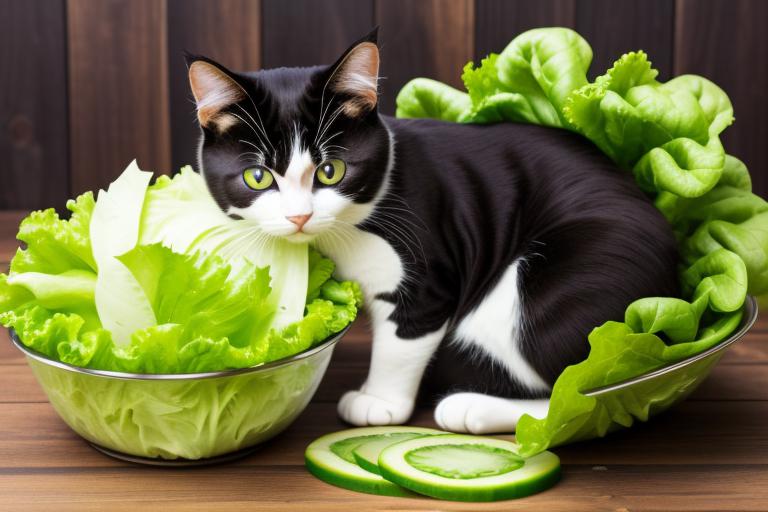Cats can benefit from the nutritional value of lettuce as it provides essential vitamins and minerals for their overall health. Lettuce is a low-calorie vegetable that can be a healthy addition to a cat’s diet. It contains a variety of nutrients, including vitamin K, vitamin A, and folate. These vitamins are important for maintaining a cat’s immune system, promoting healthy vision, and supporting overall growth and development.
Nutritional Value of Lettuce for Cats
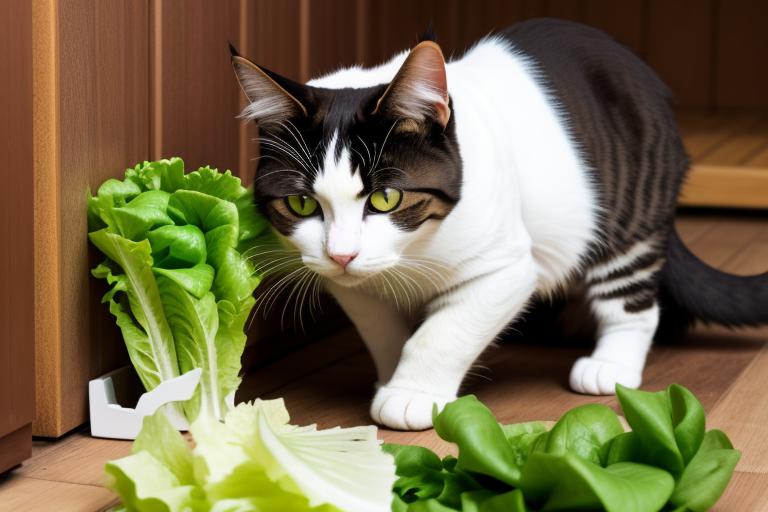
When it comes to feeding lettuce to cats, it’s important to choose the right types. Romaine lettuce and iceberg lettuce are generally safe options for cats. However, it’s important to wash the lettuce thoroughly to remove any dirt or pesticides that may be present. It’s also essential to remove any hard stems or leaves that may pose a choking hazard to your furry friend.
While lettuce can provide some nutritional benefits to cats, it shouldn’t be the primary source of their diet. Cats are obligate carnivores, which means that they require a diet rich in animal-based proteins. Lettuce can be offered as an occasional treat or as a supplement to their regular diet.
Risks and Potential Dangers
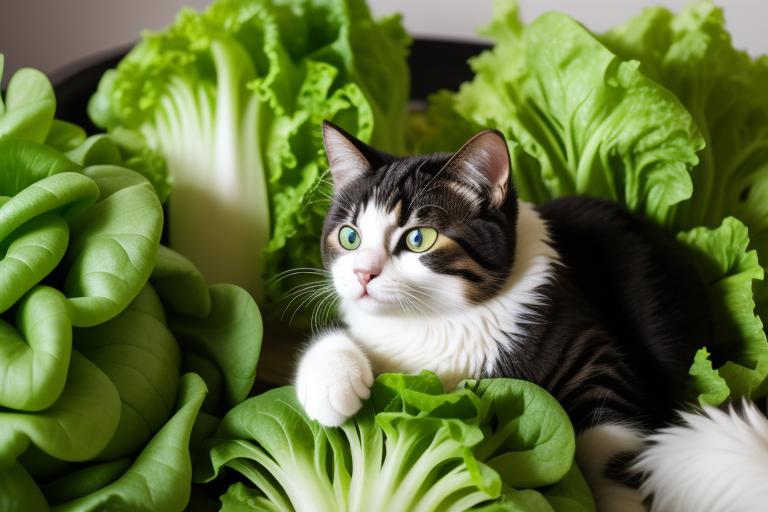
While lettuce can provide some nutritional benefits to cats, it’s important to be aware of the risks and potential dangers associated with feeding it to them. Here are some potential risks of lettuce consumption and potential digestive issues to consider:
- Choking Hazard: Cats may not chew lettuce properly, leading to potential choking hazards if large pieces are swallowed whole.
- Digestive Upset: Lettuce can cause digestive upset in some cats, leading to symptoms such as diarrhea, vomiting, or stomach discomfort.
- Pesticide Residue: If the lettuce isn’t organic or properly washed, it may contain pesticide residue, which can be harmful to cats if ingested.
- Allergies: Some cats may have allergies to lettuce, resulting in allergic reactions like itchiness, skin irritation, or even difficulty breathing.
- Intestinal Blockage: If a cat consumes a large amount of lettuce, it could potentially cause an intestinal blockage, requiring immediate veterinary attention.
To ensure your cat’s safety, it’s recommended to introduce lettuce slowly and in small quantities. Monitor your cat for any signs of adverse reactions or digestive issues. If you notice any concerning symptoms, it’s best to consult with a veterinarian. Remember, every cat is unique, and what may be safe for one cat may not be for another.
Signs of Lettuce Allergies in Cats
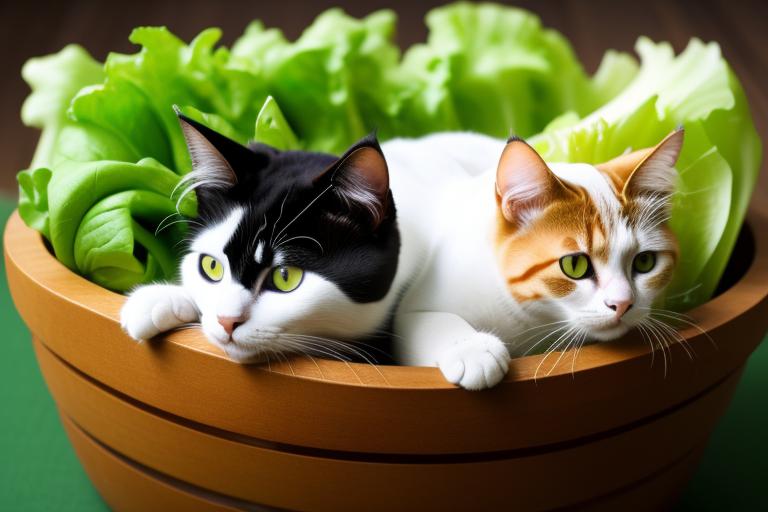
If your cat is allergic to lettuce, there are certain signs to watch for. Lettuce allergy symptoms in cats can vary, but common signs include gastrointestinal upset such as vomiting or diarrhea, excessive scratching or itching, sneezing, coughing, and even difficulty breathing. These symptoms may occur shortly after your cat consumes lettuce or comes into contact with it.
If you suspect that your cat has a lettuce allergy, it’s important to consult with your veterinarian for a proper diagnosis. They’ll be able to perform tests to confirm the allergy and rule out any other underlying conditions.
Once your cat’s lettuce allergy is confirmed, the most effective treatment option is to simply avoid giving your cat any lettuce. This means being cautious about what foods your cat has access to and ensuring that lettuce isn’t included in their diet. If your cat accidentally consumes lettuce and shows signs of an allergic reaction, it’s recommended to seek immediate veterinary care.
In some cases, your veterinarian may prescribe medications such as antihistamines or corticosteroids to help alleviate symptoms. However, these should only be used under the guidance of a veterinarian.
Precautions for Feeding Lettuce to Cats
To ensure the health and safety of your feline friend, it’s important to take certain precautions when considering feeding lettuce to them. While lettuce can be a safe addition to your cat’s diet, it’s crucial to keep these points in mind:
- Introduce slowly: Start by offering small amounts of lettuce to your cat and observe their reaction. If they show signs of digestive upset or discomfort, discontinue feeding lettuce.
- Wash thoroughly: Rinse lettuce leaves thoroughly to remove any pesticides or harmful substances that could potentially harm your cat.
- Cut into small pieces: Chop lettuce into tiny, manageable pieces to avoid choking hazards and make it easier for your cat to eat.
- Avoid dressings: Keep lettuce plain and avoid adding dressings or seasonings that may contain ingredients harmful to cats, such as onions or garlic.
- Feeding kittens: While adult cats may tolerate lettuce, it’s best to consult with a veterinarian before introducing lettuce to kittens, as their digestive systems are more delicate.
It’s worth noting that lettuce can provide some benefits to your cat’s digestion, such as adding fiber to their diet. However, always remember to prioritize your cat’s individual needs and consult with a veterinarian before making any significant changes to their diet.
Alternatives to Lettuce for Feline Diet
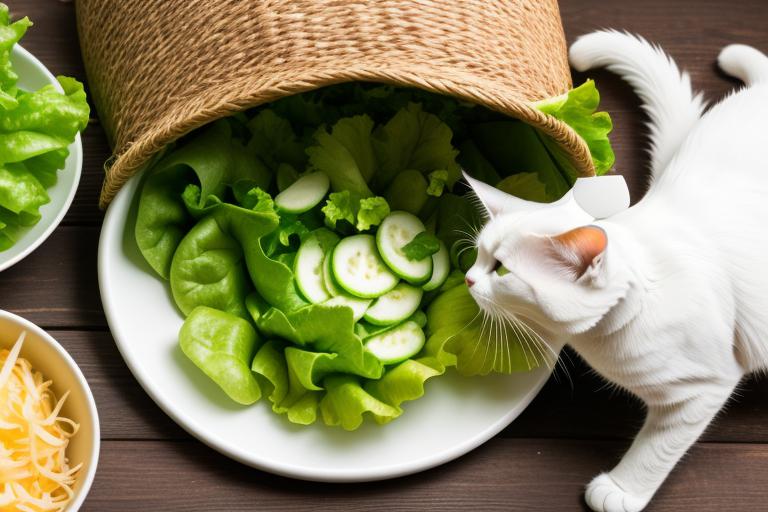
Consider incorporating other vegetables into your cat’s diet as alternatives to lettuce. While lettuce can be safe for cats in small amounts, it isn’t a necessary part of their diet. Leafy greens, however, are a great source of essential nutrients for feline consumption.
Spinach is one option that you can try. It’s packed with vitamins A, C, and K, as well as iron and calcium. Just make sure to cook it before feeding it to your cat, as raw spinach can be difficult for them to digest.
Another leafy green you can offer is kale. It’s rich in antioxidants and fiber, which can support your cat’s digestive health. Like spinach, kale should be cooked to aid in digestion.
Other safe vegetables for feline consumption include broccoli and green beans. These vegetables are low in calories and high in fiber, making them a healthy addition to your cat’s diet.
Remember to introduce new vegetables gradually and monitor your cat for any signs of digestive upset. With a little experimentation, you can find the perfect alternative to lettuce that your cat will enjoy and benefit from.
Conclusion
Overall, while cats can eat lettuce in small quantities, it isn’t a necessary or recommended part of their diet. Lettuce lacks significant nutritional value for cats and may even pose risks and potential dangers.
It’s important to monitor for signs of allergies and exercise caution when introducing lettuce into a cat’s diet. There are plenty of alternative, more suitable options available to ensure a balanced and healthy feline diet.

